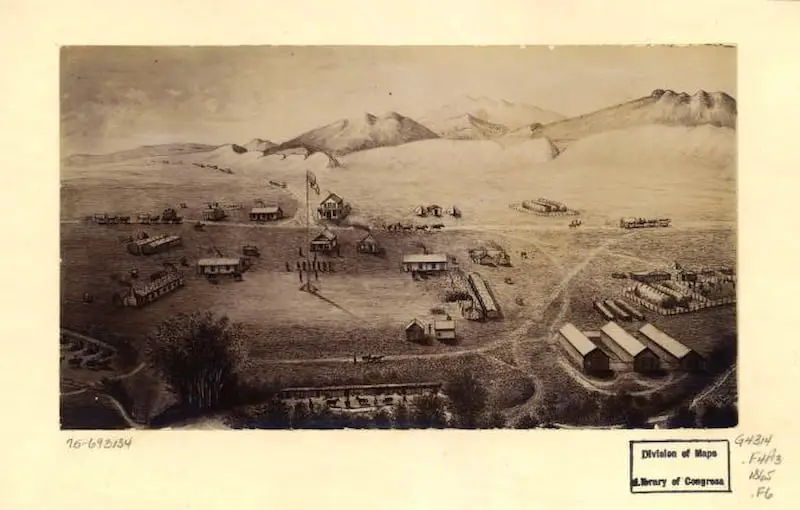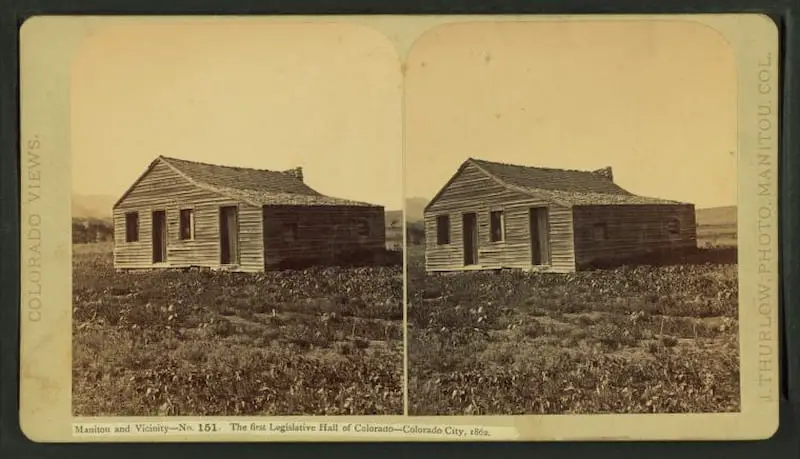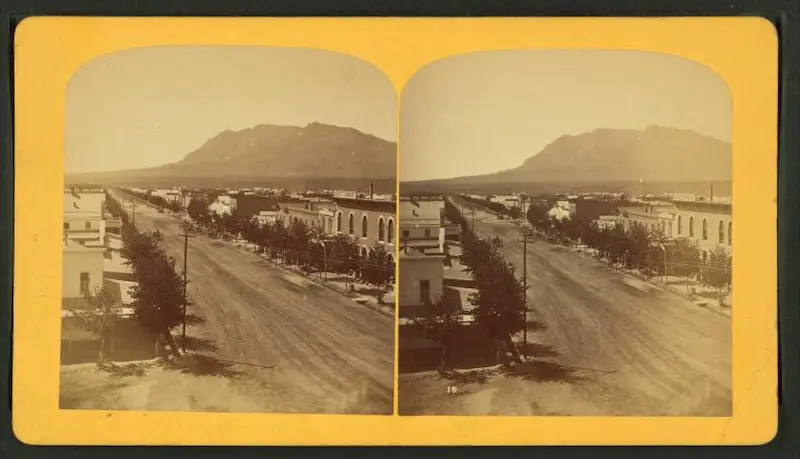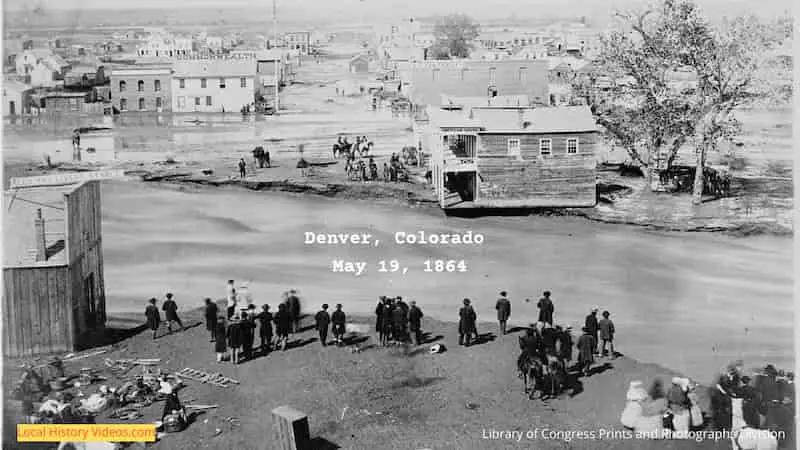Glimpse history through old images of Boulder, Colorado, in the USA.

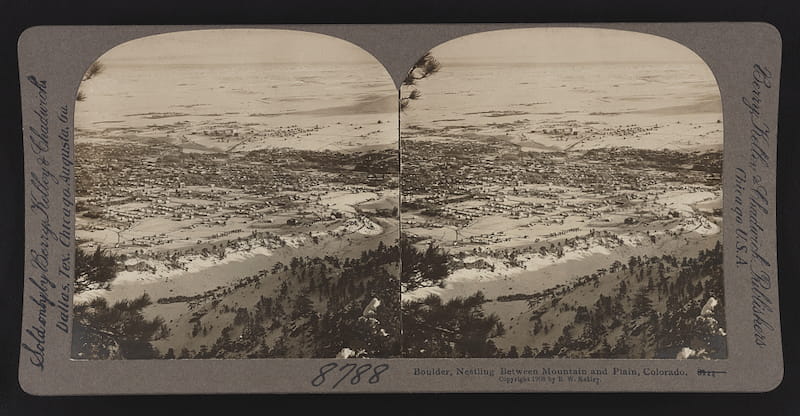
Downtown Boulder in 1967
Downtown Boulder, Colorado, about 1967 – Steve C on YouTube
A Bit of Boulder History
Extract from:
Sketch of Boulder, Colorado – Its Resources and Advantages, Together with Map and Business Directory
Published in 1873
Boulder, capital of the county of same name, has a population of about 1,500, and is situated near the foot-hills, at the mouth of the famous Boulder Canon. At no point in Colorado does there center such a variety of material resources, combined with such beauty of location. A radius of fifteen to twenty miles in length, describing a circle from this point as a center, would pass over the rich agricultural valleys of the North and South Boulder, Left Hand, St. Vrain creeks, and other smaller streams; the most abundant and extensively developed coal measures in the Territory; iron and copper deposits of almost unlimited extent and great value; more than a dozen distinct gold and silver mining districts, including the celebrated Caribou mine, in Grand Island Mining District; and one of the most thickly timbered and well-watered mountain regions to be found in Colorado; while within the same wonderful circle are scattered in prodigious profusion almost every mineral, capable of being utilized, found in the Rocky Mountains.
The natural manufacturing and commercial center of this favored area is Boulder. Within its circumference, there are no other towns of importance; Longmont, Golden City, and Caribou lying upon the outer limits of the region described.
The eastern half of Boulder County, extending from the base of the foothills, for fifteen miles along the valleys of the streams above named, embraces one of the most productive and best-cultivated farming sections of Colorado. Not only are the valley lands well-watered by the natural streams, but these are so abundant and emerge from the mountains at so high an altitude that water can be carried along all the high ridges in irrigating ditches, thus utilizing what are usually waste lands elsewhere.
A wide awake interest is taken by the citizens of the county, in the development of its agricultural interests.
Three-fourths of a mile from the city are the Agricultural Society Grounds, covering an area of forty acres, with excellent race tracks, booths, seated pavilions, and every facility for the conducting of the Fairs which are annually held, with increasing profit and interest.
Turning our attention from the plains to the foothills, we find only five miles south of the town, the celebrated coal deposits of Boulder county. There are here five distinct veins, aggregating forty feet in thickness. On the main vein, which is thirteen feet thick, several mines are being worked, the most important of which are the Marshall, Wilson, Dabny, Barber, and Allen Banks.
In close proximity to this coal are immense deposits of hematite iron ore, which assays from 40 to 70 per cent, while of such minerals as mica, gypsum, limestone, fire, pottery and brick clay, mineral paint, etc., the foothills near Boulder can furnish unlimited quantities.
About a mile from Boulder City is a quarry of reddish sandstone which will furnish unlimited building material of a superior quality, which is easily quarried into regular blocks of any required size. For the purpose of making this available, an excellent wagon road has lately been constructed to the quarry by Messrs. Wood and Allen, so that Boulder will doubtless soon be rejoicing in imposing stone edifices.
Ascending from the foothills into the mountains, we cross a broad belt of copper veins, or lodes, of varying richness, after which we find the mountains completely ribbed with rich gold and silver bearing veins to the very summit of the range. Here, within the limits of Boulder county, are the Gold Hill, Sugar Loaf, Bald Mt., Pennsylvania, Peewink, Caribou, Snowy Range, Ward, Gold Lake, Utilla, Four Mile and Jamestown mining districts. Already about a dozen stamp mills and four reduction works are in operation, and others under contemplation.
Not only is all this mining region made easily accessible from Boulder City by excellent mountain roads, but the northwest part of Gilpin county is, for the same reason, made naturally tributary to this point with its ores. This system of mountain roads, built at enormous expense, converging at a point where coal, water and timber are abundant, and where railroad facilities are ample, are the arguments which are directing capitalists to Boulder as the suitable place for the erection of reduction works on a large scale. The richness of this mining section is evidenced by the fact that the Netherland Mining Company have recently purchased the famous Caribou silver mine, for three million dollars, and are doubling the capacity of their reduction works at Middle Boulder, while several other mines within the limits of the county have lately changed hands at from ten to fifty thousand dollars.
The Boulder river, a large stream, runs through the town, and for a mile and a half from the mouth of the canon has a fall of 185 feet, thus furnishing cheap water power ample enough to run all the manufactures of the Territory.
By reference to the accompanying map it will be seen that Boulder is the center of an important railway system. By the Denver and Boulder Valley Railway, she has access to the Erie mines and to the capital of the Territory; by the Mineral Railroad, soon to be built, she will be part of a network reaching Caribou, Central, and the whole mining region; and her position on the Julesburg and Golden Railroad, now in operation, opens a direct route East, and also completes the system by which the best parts of Boulder and adjoining counties are made tributary to this promising town.
Here is, perhaps, the tourist’s best introduction to the mountain scenery of Colorado; from Denver to Golden, thence to Boulder by rail, then by stage up the canon to Middle Boulder, as picturesque a spot as a tourist could wish, to Caribou by the Cutter road, reaching one of the highest altitudes attained by a road in the Rocky Mountains, and securing a view of the plains, foothills, and snowy range that will never be forgotten. No ride of seventy miles will reveal as much variety, magnificence, and beauty of scenery as this.
The invigorating air of the foothills, excellent hotel accommodations, nearness of the mountain regions, peopled with game, and streams abounding in trout, joined to the unparalleled magnificence of the scenery, makes Boulder second to no other point in the Territory in the attractions it offers to the tourist and the invalid. We have not the space to attempt any description of the wonderful Boulder Canon, and, indeed, no words are equal to the task, but whoever, visiting the Territory fails to see it, misses probably the grandest sight Colorado has to offer.
A prominent writer says: “We have read of Alpine scenery and of the Yosemite Valley, and have seen Niagara Falls, Delaware Gap, and the passage of the Potomac, through the Blue Ridge; and we pronounce Niagara Falls, Delaware Gap, and the passage of the Potomac, as tame and commonplace when compared with the scenery of this wonderful Canon; and unless writers on Alpine Scenery and of the Yosemite Valley lack command of the resources of our language, they, too, will suffer by the comparison.”
A portfolio series of twelve views of scenes in Boulder Canon, cabinet size, for sale by Mr. Lawrence Thompson, have attracted a good deal of attention for their artistic merit.
EDUCATIONAL AND RELIGIOUS. – There is an excellent graded school of two departments, occupying a fine building, just completed, at a cost $20,000.
The Legislature has chosen this as the location of the State University. Fifty-four acres of ground, on a beautiful terrace south of the town, commanding a magnificent view of the plains and Snowy Range, have been set apart as the site for this building. The grounds will be artistically laid out and surrounded with a fine boulevard eighty feet wide. Seventy-two sections of land have been appropriated by Congress for this institution, upon which funds will soon be realized for the erection of buildings.
Of churches, there are two, Congregational and Methodist, and others in contemplation.
Literary, secret, and musical societies are among the social features of this wide-awake community.
The press is ably represented by the Boulder County News, of which Mr. W. C. Wyncoop is the editor and proprietor.
The following is a list of the business houses: 1 bank; 3 hotels; 2 flouring mills; 1 planing mill; 2 drug stores; 2 hardware stores; 1 boots and shoes; 1 tailor; 3 real estate agents; 5 physicians; 3 milliners; 9 general stores; 1 gunsmith; 1 brewery; 3 blacksmiths; 5 attorneys; 1 agricultural store; 3 jewelers; 2 butchers; 3 livery stables; 1 furniture store.
Distances: Boulder to Denver, by stage: 28 miles; by railroad: 46; to Golden: 24; to Erie: 12; to Longmont: 15; to Caribou: 20; to Cutter’s Reduction Works: 16; to Central City: 30; to Georgetown: 42; to Julesburg: 180; to Ward: 17; to Peabody Springs: 10; to Gold Hill: 9.
The following statistics of Boulder county in the assessment of 1872, will be of interest: Population of county, 5,500; acres of land assessed, 65,679; value, $248,221; value of farming improvements, $405,421; value of farm products, 1872, $653,000; value of horses, $152,127; of mules, $16,730; of cows, $153,832; of calves, $22,938; capital employed in manufactures, $18,000; total valuation, $1,295,395.
The following is the Boulder county tax list for 1872: Total valuation of property, $1,215,495; county tax, ten mills on the dollar, $12,154.95; school tax, five mills on the dollar, $6,077,46; road tax, one and a half mills on the dollar, $607.74; lunatic and pauper, one and a half mills on the dollar, $607.75; poll tax, fifty cents each, $321; total amount of taxes, $23,415.33.
We take pleasure in referring all parties desiring information respecting the resources of Boulder county to Mr. T. J. Graham, Secretary of the Territorial Board of Immigration for Boulder County.
History of Boulder County
This video ventures into the rich past of Boulder County in Colorado. It uncovers the origins of the county, originally inhabited by the Cheyenne and Arapahoe peoples. While settlers arrived, the Native Americans were hunting and fishing in the region, having been granted the land in 1851 by the Fort Larambique Treaty Council.
Interestingly, reports of ‘Indian attacks’ were mainly concentrated in the eastern part of Colorado territory, leaving the settlers untouched. However, the staking of gold claims around Gold Hill in the mountains caused desperation among the people.
Gold Hill itself came into existence alongside these gold claims, though the original settlement unfortunately burned down due to a forest fire. Nevertheless, the town was resilient and was relocated closer to a water source. Today, some buildings from the 1880s can still be seen in Gold Hill.
There was competition between Valmont and Boulder to become the county seat.
Valmont had an advantage with the county’s first newspaper, the Valmont bulletin. However, fate took a surprising turn when a man from Boulder stole presses from Valmont, sparking a chain of events that led to the establishment of the Boulder Valley News. As a town without a newspaper wouldn’t succeed, Valmont’s chance at becoming a county city was dashed.
Moving beyond the towns, the video explores the natural landscape of the short grass prairie, where buffalo and pronghorn once raced. Streams in the past were wider and deeper, as they were not yet affected by irrigation water diversion. Wagons could only cross at specific places due to the depth of these streams, such as Pella and Burlington. It also sheds light on the early pioneer families who established homesteads along streams or brought young whips from the Midwest.
The process of establishing a homestead left little time for socializing, but the pioneers made efforts to participate in clubs and gather at places like the blacksmith shop or feed store to exchange news. Women were also active in community activities, as seen in a photograph of the residence Sunshine during a “zombie picnic.” Quilting bees and range meetings were common social practices in this community.
Altona was a community that no longer exists but left traces in history. It was designated as a toll gate to a road that was meant to connect the plains to the city, though the road itself was never completed. Despite its short-lived existence, Altona had a few buildings, including a post office.
The creation of Boulder County in 1862 as part of Colorado territory and the passage of the Homestead Act attracted thousands of families to the west from the Midwest. The journey itself took several weeks, but the promise of gold in the Rocky Mountains enticed many miners. English coal miners settled near Marshall, living in tents until they could build permanent homes. Sawmills became instrumental in frame construction, with dimension lumber being available.
The video concludes with a glimpse into Burlington, an agricultural town located south of present-day Longmont. Although it did not become a large town, Burlington boasted several amenities, including hotels, stores, and an entertainment hall. It served as a vital stage stop on the Overland route, connecting Denver to Cheyenne and Salt Lake City. The Overland stage operated in Eastern Boulder County during the 1860s.
Agriculture played a significant role in the county’s development, starting with the harvesting of prairie grasses that were already growing. The demand for these grasses was high due to the use of draft animals in mine camps. Farmers even transported the grasses as far as Blackhawk and Central City, making a lucrative trade.
History of Boulder County – Boulder County Open Space on YouTube


